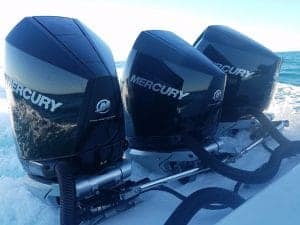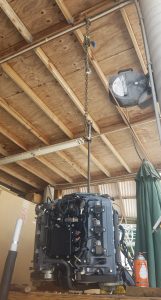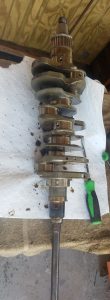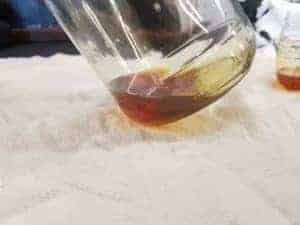I’m sure you have heard of the “break in period” for a new car, new motorcycle, or a new boat! I have been asked a lot of times, do I really need to do this. Is it really that important?
What Is A Break In Period? Break in period is the time it takes for a brand new engine’s parts to properly wear into each other. The seating of rings, wearing of gears, and grinding of bearings creates dirty oil and “breaks in” the engine.
Performing this process the right way is extremely important and plays into the longevity and reliability of the engine! Here is what you need to know!
A Little About New Engines
New engines fresh out of the factory have all new gears, bearings, pistons, piston rings, and other moving parts inside of them that have just been machined.
They still have a lot of very sharp edges and hatches on the cylinder walls.
The very first few hours or miles that the engine is run for are very crucial to the overall performance that this engine will produce.
If the engine is run as hard as possible right out of the box; then these parts might not mesh properly.
This ends up shortening the lifespan of the engine.
If the engine is not run hard at all, it will cause these components to improperly mesh together and not seat properly; which will also have a toll on the lifespan of the engine.
As an engine runs it produces a lot of heat. Most of the components that are inside of a combustion engine have been forged using heat.
So if they get too hot while they are brand new, it can affect the wearing of them. If they don’t get hot enough, it will also have an effect on the wearing process.
Engine Break-in Myth!
The biggest controversy concerning the engine break-in period is the idea that it is all a myth.
Some people may take these myths the wrong way if they don’t listen to both sides of the story.
From what I can gather, the biggest opponents to the break-in period, are not really against whether or not there should be a break in period.
However, the argument seems to be more focused on the duration of the break-in period.
The biggest thing in the break-in period is the rings that are around the pistons which help create the compression for the engine.
They are worn in and seating during this initial “break-in period.”
This affects the overall reliability and performance of the engine and is the single most important part that is being “broken in.”
There was a time, long, ago. That the break-in period was this extremely long period of time that manufacturers wanted people to go through.
Over the years with the advancement of machining and materials, we have come to see that this long period of time really isn’t that necessary.
But there are a lot of old schoolers out there that stand by this.
So to say that there is a break-in period myth is more just saying that people are getting the wrong idea and that dealers and others are giving misinformation and half-truths about what the break-in period really is.
Why it is Important to Break in Your Engine?
Like we just talked about. The most important part of the break-in period is the seating and wearing of the piston rings.
It’s what helps create the compression and the performance of the engine. This affects the fuel economy, the oil burning, and overall, the longevity of that engine.
If the engine is not properly broken in, you could be looking at a shorter life, and incurring problems over the time you own the engine.
Is this the absolute case for all engines? No, not really, there is always an exception, but do you really want to risk it, when it is YOUR money?
I can tell you first hand from experience in the marine industry that I have seen brand new engines come out of the box and go onto a boat; Then ran at wide open throttle (WOT) straight out the gate!
I mean, from the time the engine was put on, and the boat back into the water, it was sticks down, trimmed up, and hauling it to the spot, immediately!
These engines had an average life span of about 2000 hours. With a little bit of wiggle room, sometimes more, sometimes less. 1900 hours, sometimes 2400 hours.
But that was the general for all of the engines that were rode hard like that. Then at the same time, the ones that got broken in properly, are still in use with up to 6000 hours!
What is the Proper Procedure for Breaking in?
So, we really need to talk about how to properly perform this break-in period right?
There can be some variables depending on the manufacturers, but for outboard engines, it is basically all the same. Regardless of the brand.
Yamaha, Honda, Mercury, or Suzuki, they are all basically the same.
Even most inboards for that matter, they all follow the same principles and guidelines with a few changes on how long this should all be performed.
The goal is to keep the engine from both ends of the spectrum, that is idle, and WOT. The rule of thumb for most marine engines are 10 hours for the break-in period.
Some inboards require more, like a 20-hour break in, but I think this could go back to the debate of the “break-in period myth.”
So we will leave that there with what the manufacturers want, and say. That is entirely up to them.
This 10 hour period of time starts from the very second the engine starts. When the engine is running, the clock is ticking.
So starting the engine and going to a safe place for operation is key.
The trick is to find a number that is easy for you. I like to use 5, 10, or 15. It makes it easy to keep track of when looking at a clock or a watch.
You want to change the RPMs on one of these numbers. So every 5, 10, or 15 minutes you want to change to a different RPM.
In my opinion, the first 2 hours are the most crucial hours. I like to stick with the 5 and 10 minutes.
So I will run the engine at 3500 RPMs for 10 minutes. Then I will change it to 2500 RPMs for another 10 minutes. Then go up to 4500 RPMs for another 10 minutes.
The numbers don’t have to be exact, we are just trying to make sure that we change the load that is being put on the engine by varying the RPMs.
The other little kick is that twice an hour you can go wide open throttle, but for no more than 5 minutes at a time.
Once you get past the initial 2 hours of operation. Then you can go up to the 15 minutes and then change, but keep on this same pattern.
With no more than two times per hour of wide open throttle for no more than 5 minutes at a time and changing the RPMs about 1000 RPMs to where ever you would like.
Keeping them between 1500 and 5000 RPMs.
Do this for 10 hours and you have successfully broken in your engine, and are going to have minimal oil consumption and better fuel economy!
Is the 20 Hour Service Necessary?
Which brings us to the next crucial step in this entire process, and that is the 20-hour service.
This is basically when you change the oil after performing this break-in process. You want to get all of that dirty and metal-like oil out of the engine and get some clean lube into it.
Dirty oil with debris and oil contaminants can wear rings and other scratches into the internal parts of the engine if run for too long.
Understanding what is going on and the process that has just taken place when starting out with a brand new and fresh engine leads us to understand the need to change the oil.
Changing the engine oil at 20 hours is absolutely necessary, in my opinion.
I don’t really care what anybody says, it’s dirty oil and if it’s my money and my engine, I’d rather spend the money to avoid any problem period. Whether there are exceptions or not.
What Kind of Oil is Best for Break in?
This brings us to another controversial subject, and that is what kind of oil is best for breaking in a new engine.
Years ago the rule of thumb was that you don’t want to use a synthetic blend of oil for break-in and that conventional oil was the way to go.
Oils these days and the production of the engines that are coming out of the factories; are way more tolerable than they used to be.
Most manufacturers use their own brand of either fully synthetic or a semi-synthetic blend, right in the factory.
There are also “break-in” oils out there that are specifically designed to be used during the break-in period.
Oils like Royal Purple break-in oil, Amsoil, and Mobil 1 all have break-in oils that are designed with the right additives to help cling to the insides of the engine.
This provides better lubrication to the piston rings, cylinder walls, and valves.
I would suggest that in my opinion, using what the manufacturer calls for, or a specific break-in oil is going to be your best bet.
Do You Still Have To Break In New Cars or Trucks?
As far as a true break-in period on new cars. Most new cars have their engines broken in at the factory before they even hit the road.
Of course, it is not a good idea to just throttle down and redline the engine of a brand new car; but as far as performing a break in for the 1000 miles, I wouldn’t worry too much about it.
Just take it easy on the car and get that oil changed within the specified time or mileage that they require!
Something else that you might find very interesting is what are thoughts are on Whether A Boat Is A Good or Bad Investment!
We also have some really helpful information that can help You Decide What Is The Best Boat For You and Whether or Not You Need An Inboard Boat or An Outboard Boat!
Check Us Out!
We hope this helps you out and gives you a better understanding of what a “break-in period” is for a brand new or rebuilt engine!
If you’ve got any questions or comments, let us know by subscribing to our YouTube Channel!
And if you would like to support us to continue bringing you great content, please click the link below to Amazon where we get a commission from anything you are already going to buy!
Click Here To Amazon!
And you can also donate by clicking the donate button here or on the right hand of the screen!
It really helps us out and we thank you so much for your support!
Thanks for reading and we look forward to reading your responses and comments.
We’d like to invite you to come and check us out on our YouTube Channel: Born Again Boating! Where we make all kinds of boating and how to outboard service videos!
We hope you will get subscribed to the channel and add this site to your favorites to allow us to become your go-to resource when it comes to getting your how-to and DIY boating projects done!
Thanks for stopping by and we hope to see you around!





